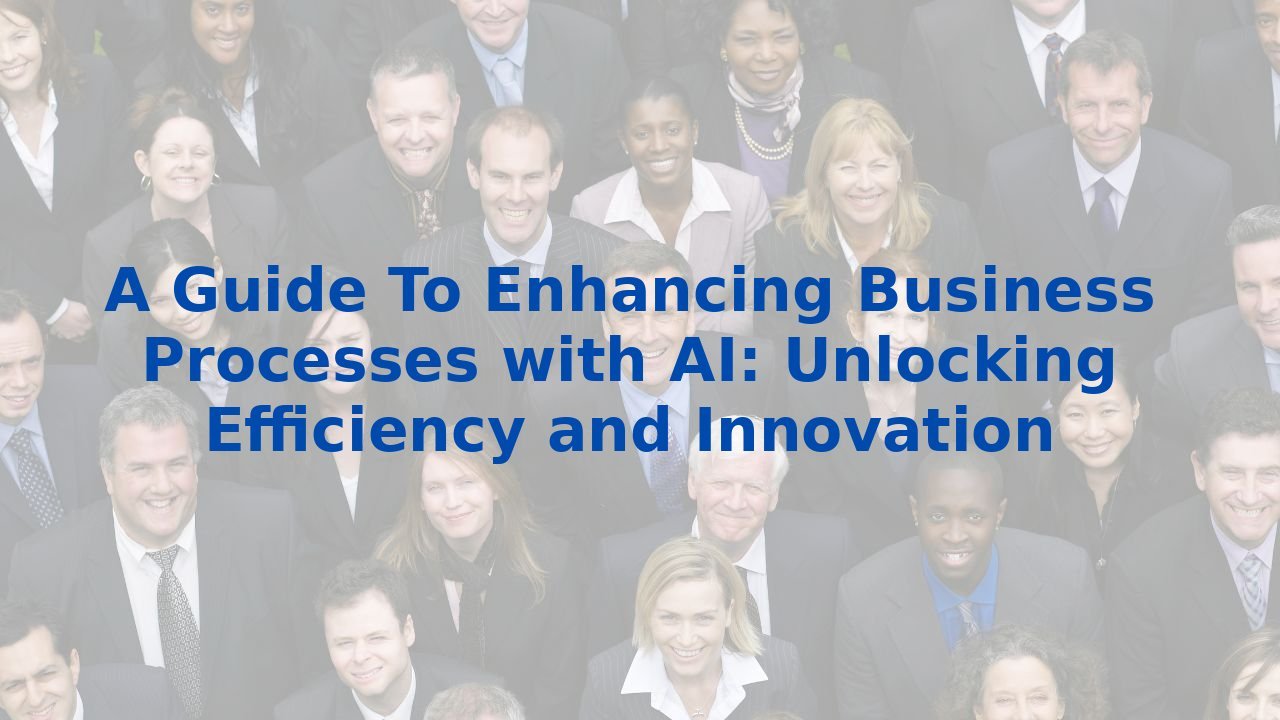A Guide To Enhancing Business Processes with AI: Unlocking Efficiency and Innovation
A Guide To Enhancing Business Processes with AI: Unlocking Efficiency and Innovation
Introduction
In an era marked by relentless change, organizations are on a relentless quest for efficiency and innovation. At the forefront of this transformative journey is Artificial Intelligence (AI). By integrating AI into business processes, companies not only enhance their operational efficiency but also pave the way for innovative breakthroughs. This guide explores how AI can breathe new life into business processes and why training your workforce is key to unlocking its full potential.
Understanding Business Process Management
Business Process Management (BPM) forms the backbone of any successful organization. It involves the systematic approach to analyzing, designing, and optimizing workflows to drive productivity. A well-structured BPM can lead to improved quality, heightened customer satisfaction, and cost savings. However, the complexity and dynamic nature of modern business environments pose unique challenges that traditional methods may struggle to address.
The Role of AI in Business Process Management
AI is reimagining BPM by providing innovative tools that analyze massive datasets, revealing insights that drive efficiency. Let’s delve into how AI is reshaping core business processes:
1. Process Discovery and Mapping
AI’s capabilities extend to process discovery and mapping through advanced techniques like process mining. By analyzing existing workflows, AI can unveil hidden inefficiencies and bottlenecks. This creates actionable blueprints that organizations can use to refine their operations, translating raw data into visual insights.
2. Process Automation
Every organization faces mundane and repetitive tasks that drain valuable human resources. Through automation, AI alleviates this burden. Intelligent document processing (IDP) exemplifies this by converting documents into usable data without manual oversight. The result? Enhanced speed, accuracy, and a significant reduction in error margins.
3. Real-Time Monitoring and Optimization
Imagine a system that continuously tracks your organization’s performance, alerting you to potential issues as they arise. AI-powered monitoring tools do just that, allowing businesses to address concerns proactively while optimizing processes on the go. This not only improves efficiency but also fosters a culture of adaptability.
4. Decision Support
Data-driven decision-making is paramount in today’s landscape. AI provides predictive analytics that can simulate various scenarios, empowering executives to make informed choices. This leads to smarter strategies that align with organizational goals and market demands.
5. Enhancing Customer Service
AI plays a pivotal role in revolutionizing customer service. Through chatbots and automated response systems, businesses can offer personalized support while mitigating the workload on human agents. This not only enhances customer satisfaction but also drives revenue growth through improved engagement.
Benefits of AI for Improving Efficiency
The advantages of integrating AI into business processes are profound:
- Increased Efficiency: AI automates tedious tasks, allowing employees to focus on more strategic endeavors.
- Improved Accuracy: The data processing capabilities of AI reduce errors significantly.
- Enhanced Decision-Making: AI delivers actionable insights that support informed choices.
- Cost Reduction: Automation minimizes labor costs and reduces expenses related to human error.
- Enhanced Customer Experience: AI-driven tools provide a seamless, satisfying experience for customers.
The Importance of Employee Training
While AI offers remarkable capabilities, its success is intrinsically linked to the skills of the workforce. Employee training ensures that teams understand AI's capabilities and limitations, facilitating a smoother integration into workflows.
- Understanding AI Capabilities: Employees must grasp how AI can complement their work rather than replace it.
- Data Quality: Training employees on data management is crucial, as AI systems rely on clean, accurate data to function effectively.
- Adapting to Change: Continuous learning fosters resilience and adaptability amidst technological advancements.
- Collaboration with AI: When employees learn to work alongside AI, organizations can harness its full potential, leading to synergistic outcomes.
Conclusion
Embracing AI is not merely a technological upgrade; it’s a strategic imperative for organizations seeking to thrive in a competitive landscape. By understanding its role in business process management—from discovery to optimization—companies can realize significant efficiency gains. Moreover, prioritizing employee training will ensure that your workforce is not just onboard with AI but is empowered to leverage it for transformative results.
As we venture deeper into the realm of AI, the message is clear: investing in technology and your people is the dual pathway to unlocking innovation and efficiency in business processes.



